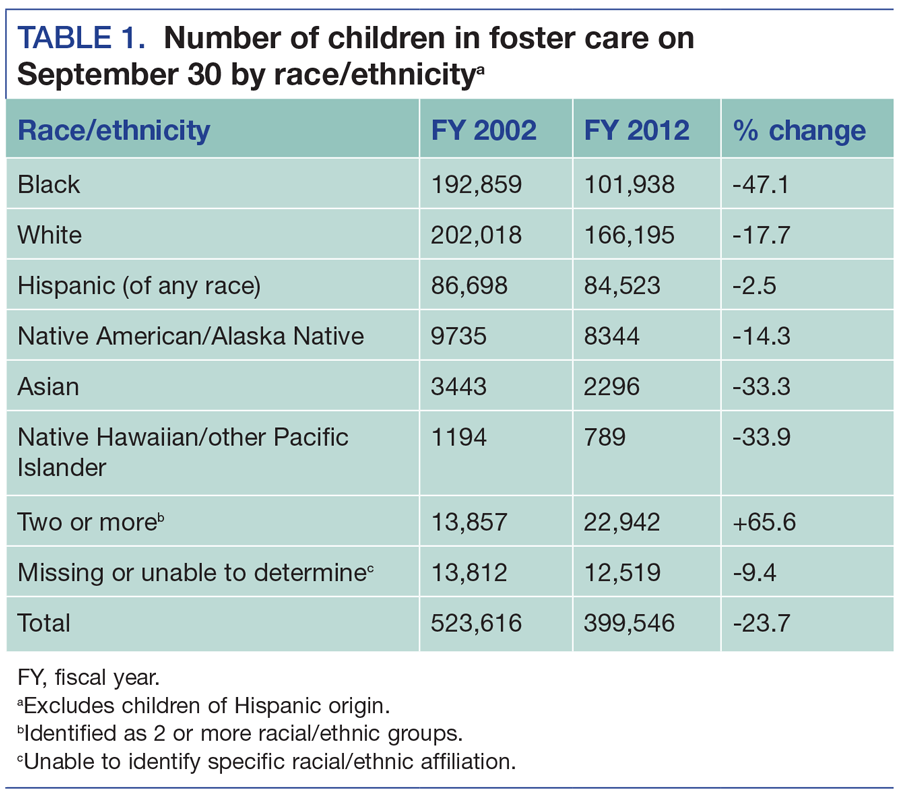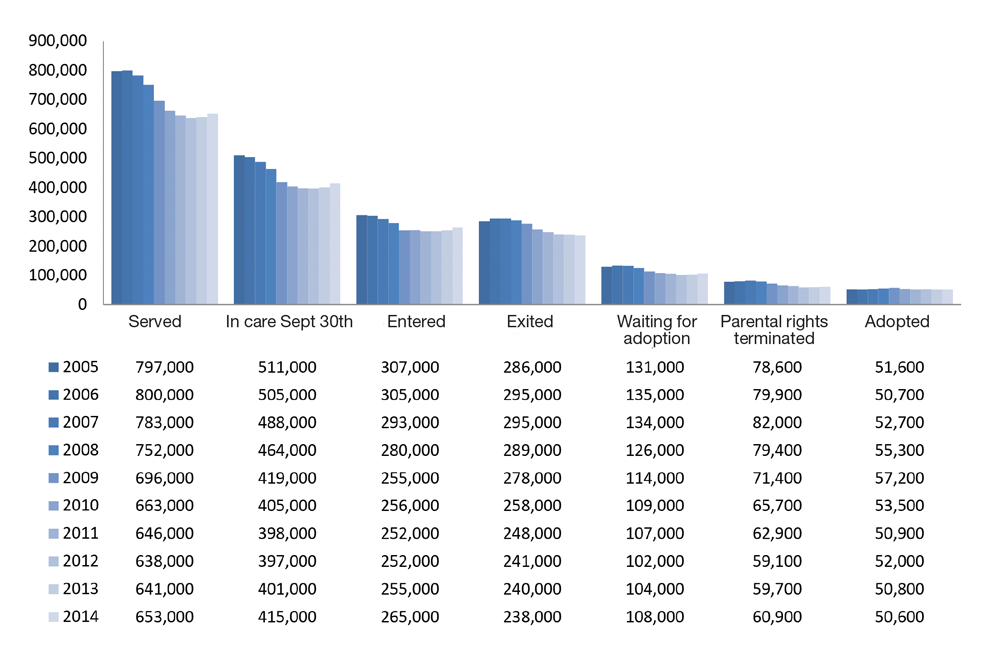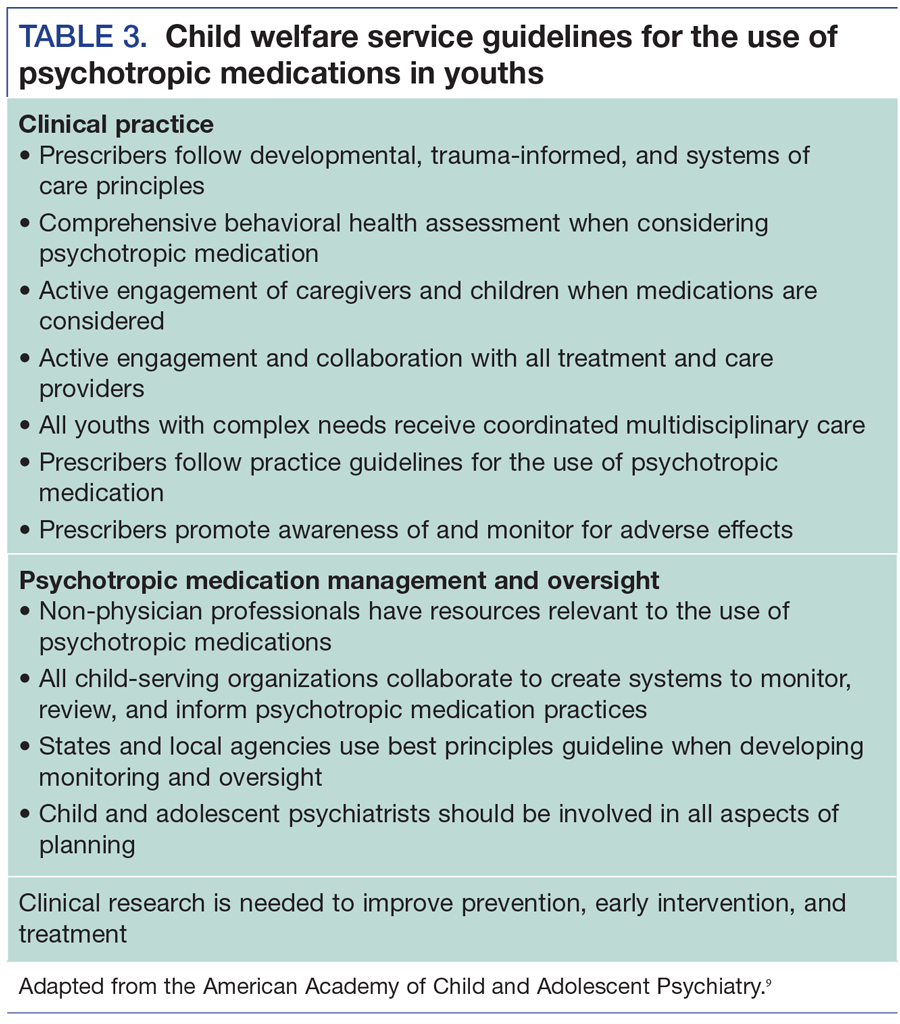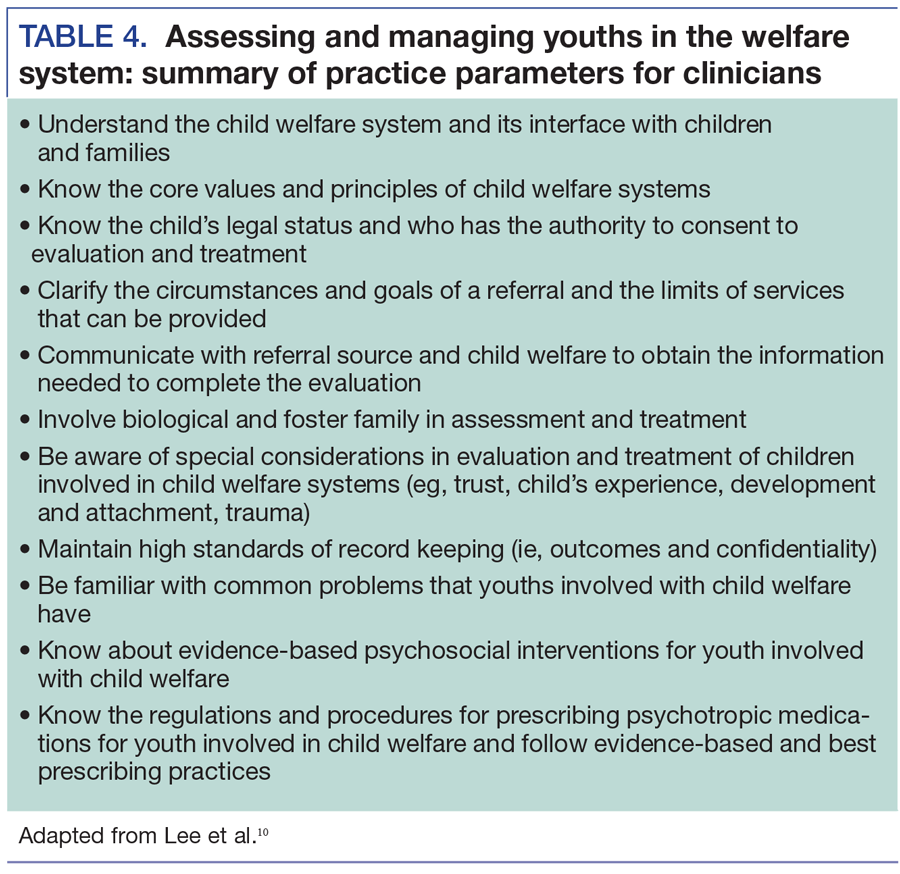Publication
Article
Psychiatric Times
Children in Foster Care: Issues and Concerns
Author(s):
Here's how the general psychiatrist can play a greater role in better outcomes for children in foster care.
TABLE 1. Number of children in foster care on September 30 by race/ethnicity

TABLE 2. Summary of guidelines for psychiatric treatment of children in state custody

Figure. Trends in foster care and adoption: FY 2005 - FY 2014

TABLE 3. Child welfare service guidelines for the use of psychotropic medications in youths

TABLE 4. Assessing and managing youths in the welfare system: summary of practice parameters for clinicians

Child maltreatment is a broad term that includes neglect, physical abuse, sexual abuse, and emotional abuse; however, the US Department of Health and Human Services reports only on neglect and physical and sexual abuse. In the US, neglect is the most common form of maltreatment (75%), followed by physical abuse (17%), sexual abuse (8.3%), psychological maltreatment (6%), and medical neglect (2.2%).1
The response to a report of alleged maltreatment is set by each state but typically includes an initial screening. When the screen is positive, Protective Services conducts an investigation to determine whether maltreatment occurred or provides an alternative response to identify the needs of the child and family.
The number of children in foster care has declined substantially over the past decade, from about 800,000 in 2005 to roughly 650,000 in 2014 (Figure).2 This trend has been true across most racial and ethnic groups; however, the rate has increased among mixed-race children (Table 1).3 Although the percentage of African American children in foster care has declined substantially, the rate is still about twice the national average. The overall duration of stay in foster care has declined during this period as well. These trends coincide with concerted efforts at the national and state level to increase family preservation services and to achieve permanency.
Mental health disorders of children in foster care
The prevalence of both medical and mental health problems among children in foster care is high. One study of children in foster care aged 2 to 14 years identified nearly 50% with clinically significant mental health problems.4 In a similar study of teenagers, 42% had at least one mental health disorder; of these, nearly one-third had 2 disorders and one-fifth had 3 disorders.5
A number of factors contribute to risk. Children in foster care are more likely to have been exposed to substances in utero, have a higher rate of family psychiatric problems, are more likely to experience substance use in parents and caregivers (2- to 3-fold higher in victimized vs non-victimized children), are less likely to have had consistent prevention and primary care services and, by definition, have experienced one or more instances of maltreatment. The presence of health and mental health challenges can also increase the risk of disrupted foster care placements and poor continuity in health and mental health care, thus compounding the loss and trauma.
CASE VIGNETTE 1
Tony, a 7-year-old boy, is placed in a short-term residential facility for assessment following failure of a foster care placement related to aggression and destructive behavior. From birth until age 6 he was in the care of his birth mother, but protective services were engaged periodically following allegations of neglect. Tony’s father briefly had custody several months before residential placement, but custody was revoked after an allegation of abuse stemming from physical discipline. Tony has been taking stimulant medication for the past 3 years.
While in the assessment facility, Tony demonstrates highly disruptive behavior, including property destruction, physical aggression, and self-injurious behavior. He also makes suicidal and homicidal threats. These behaviors become unmanageable in the residential setting, and Tony is hospitalized.
During admission, the stimulant is discontinued and an alternative stimulant and topiramate are started with Tony’s mother’s consent. On return to the assessment center, behavioral problems continue and after discussion with Tony’s father, clonidine extended- release is added. Tony’s mother objects to this recommendation but chooses not to fight it legally. Within 1 week, Tony is moved to a foster home.
Medicaid prescription claims data from 5 states showed that the rates of psychotropic medication use ranged from 2 to 5 times higher in children in foster care compared with non-fostered children served by Medicaid.6 A follow-up report based on in-depth child welfare case reviews in each of these 5 states raised concerns about the effect of care quality on prescribing trends.7 Specifically, the child welfare case reviews revealed that:
• In a substantial minority of cases, the clinical documentation within the child’s foster care record did not support psychotropic medication use.
• Only in a minority of cases did the child welfare record reflect efforts to provide evidence-based psychotherapeutic interventions.
• In those cases in which concomitant psychotropic medications were used, the documentation of rationale in the child’s case file was much less common.
• Documentation of informed consent was absent in about one-third of the cases and fully documented in about one-fourth.
• In one-third of the instances in which psychotropic medications were used in infants, there was no clear documentation in the child’s case file of the reason for the medication recommendation.
• Multiple medications at relatively high doses were common during inpatient treatment.
CASE VIGNETTE 2
Jessica is a 17-year-old who has been in the foster care system for many years. She was placed in residential care because of conflict with her latest foster family. She has a long history of mental health treatment in outpatient and inpatient settings. She reports highly variable emotional states, typically brief in duration and reactive to circumstances.
At the time of admission to residential care her medication regimen included chlorpromazine, fluoxetine, lurasidone, lamotrigine, trazodone, and oxcarbazepine. There is limited information about the chronology of medication treatment and no records of psychotherapy services.
Jessica is not able to provide much information about her response to the medication regimen, and there are no other sources of collateral information. In spite of this complex regimen, she continues to demonstrate frequent shifts in emotions and aggressive behavior, most often related to interpersonal conflict or to small disappointments. On one occasion, she became physically aggressive, which led to assault charges and a 72-hour incarceration. The plan is for her to transition to an adult foster care facility after her 18th birthday.
CASE VIGNETTE 3
Adam had been placed in residential care for sexual offender treatment following allegations of criminal sexual conduct. He had received a diagnosis of bipolar disorder and was taking olanzapine, fluoxetine, and lorazepam. Past assessment and treatment records are limited. Adam reports that between the ages of 8 and 16 his stepfather sexually abused him. The abuse was discovered inadvertently, and soon thereafter Adam was placed in foster care. Notably, the abuse was not disclosed or discovered when bipolar disorder was diagnosed. Adam reports multiple symptoms consistent with PTSD, most prominent of which are nightmares and hypervigilance.
In residential placement, Adam participates in formal sexual offender treatment and receives intermittent exposure to cognitive behavioral techniques, but no sustained course of cognitive behavioral therapy or any other treatment specific to PTSD. The fluoxetine dosage is increased with some reduction in anxiety, and prazosin is added to address nightmares with some success. The olanzapine is maintained, although Adam does not report any benefit from it.
After his 18th birthday, he is ambivalent about treatment. Sometimes he expresses a desire to complete sexual offender treatment and then transition into the community; at other times he expresses a desire to leave but needs a set of supports and treatment in place. His social worker and residential staff believe his plans about leaving are unrealistic; however, they cannot do much to help him. Now that he is 18, all the parties involved in his care are limited to providing advice.
Consensus guidelines for children served by child welfare
The American Academy of Child and Adolescent Psychiatry (AACAP) has published guidelines to help clinicians who provide clinical services to children in foster care. In 2011, the AACAP Committee on Community Based Systems of Care developed a set of basic principles for the care of children in state custody (Table 2). In 2015, an additional set of guidelines specifically related to the use of psychotropic medications in this population (Table 3) was published. The AACAP also published a practice parameter for the assessment and management of youth involved in the child welfare system (Table 4).
Summary
Psychiatrists encounter multiple challenges in providing quality care for children served by child welfare agencies across the continuum of care. The first of these are limitations in the existing knowledge base, especially the impact of maltreatment on clinical presentation and diagnosis. It is incumbent on psychiatrists to pursue continuing education in this area and to support advocacy efforts to fund bench and clinical research.
A second challenge is obtaining treatment records. Records may exist in several places and might predate foster care placement. Although some state laws expressly require legal parents to disclose all current and prior providers and to provide consent for release of records, it is difficult to get all of the parties (health care providers, foster care personnel, and parents) to coordinate efforts and obtain records.
A third challenge is ensuring that health and mental health care organizations fully support the infrastructure needed to provide quality care as recommended by the AACAP. Allowing time to review earlier records, ensuring access to all collateral sources of information, and committing to child and family engagement in shared clinical decision-making are critical. Child and adolescent psychiatry must provide leadership within their organizations to develop the means to ensure quality assessment and treatment.
Finally, young adults coming from foster care are legally empowered to engage in decision-making about health and mental health care. However, the consequences of trauma exposure and the current realities of the broader systems of care leave them ill-equipped to engage in independent decision-making. These young adults are more likely to engage in behaviors that increase their odds of inpatient psychiatric care and criminal justice involvement.
The general psychiatrist can play a greater role in better outcomes for children in foster care. Understanding the long-term consequences of child maltreatment and child welfare systems allows psychiatrists to help the treatment team provide appropriate services and supports and to advocate for community-wide support systems for these youths.
Disclosures:
Dr. Scheid is Associate Professor in the department of psychiatry at Michigan State University. She is former President and current Chair of Membership of the Michigan Psychiatric Society. She reports no conflicts of interest concerning the subject matter of this article.
References:
1. US Department of Health & Human Services, Administration for Children and Families, Administration on Children, Youth and Families, Children’s Bureau. Child Maltreatment 2014. http://www.acf.hhs.gov/programs/cb/resource/child-maltreatment-2014. Published January 25, 2016. Accessed May 12, 2016.
2. US Department of Health and Human Services, Administration for Children and Families, Administration on Children, Youth and Families, Children’s Bureau. Trends in Foster Care and Adoption: FY 2005 – FY 2014.
http://www.acf.hhs.gov/sites/default/files/cb/trends_fostercare_adoption2014.pdf. Accessed May 12, 2016.
3. US Department of Health & Human Services, Administration for Children and Families, Administration on Children, Youth and Families, Children’s Bureau. Recent Demographic Trends in Foster Care. http://www.acf.hhs.gov/programs/cb/resource/data-brief-trends-in-foster-care-1. Published September 2013. Accessed May 12, 2013.
4. Burns BJ, Phillips SD, Wagner HR, et al. Mental health need and access to mental health services by youths involved with child welfare: a national survey. J Am Acad Child Adolesc Psychiatry. 2004;43:960-970.
5. Heneghan A, Stein R, Hurlburt MS, et al. Mental health problems in teens investigated by US child welfare agencies. J Adolesc Health. 2013;5:634-640.
6. Government Accountability Office. Foster Children: HHS Guidance Could Help States Improve Oversight of Psychotropic Prescriptions. GAO-12-270T. http://www.gao.gov/products/GAO-12-270T. Published December 1, 2011. Accessed May 12, 2016.
7. Government Accountability Office. Foster Children: HHS Could Provide Additional Guidance to States Regarding Psychotropic Medications. GAO-14-651T. http://www.gao.gov/products/GAO-14-651T. Published May 29, 2014. Accessed May 12, 2016.
8. American Academy of Child and Adolescent Psychiatry. Position Statement on Oversight of Psychotropic Medication Use for Children in State Custody: A Best Principles Guideline. 2011. https://www.aacap.org/App_Themes/AACAP/docs/clinical_practice_center/systems_of_care/FosterCare_BestPrinciples_FINAL.pdf. Accessed May 12, 2016.
9. American Academy of Child and Adolescent Psychiatry. Recommendations About the Use of Psychotropic Medications for Children and Adolescents Involved in Child-Serving Systems. 2015. https://www.aacap.org/App_Themes/AACAP/docs/clinical_practice_center/systems_of_care/AACAP_Psychotropic_Medication_Recommendations_2015_FINAL.pdf. Accessed May 12, 2016.
10. Lee T, Fouras G, Brown R, for the AACAP Committee on Quality of Care Issues. Practice parameter for the assessment and management of youth involved with the child welfare system. J Am Acad Child Adolesc Psychiatry. 2015;54:502-517.






